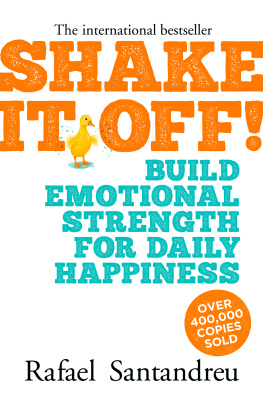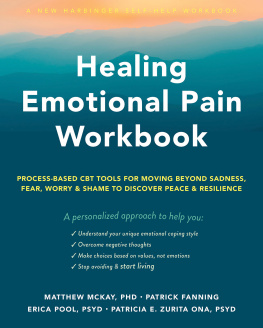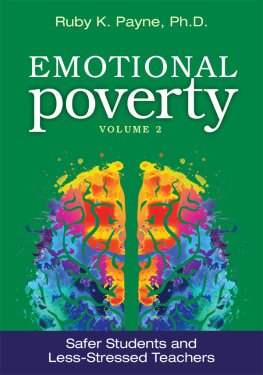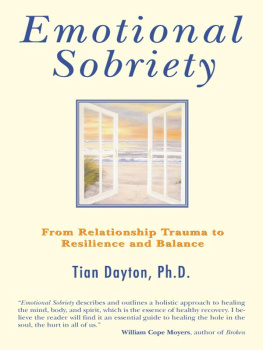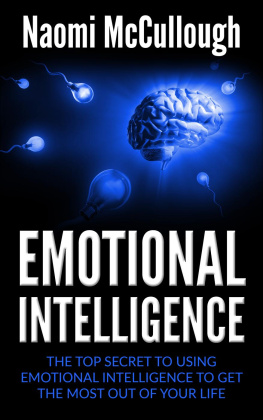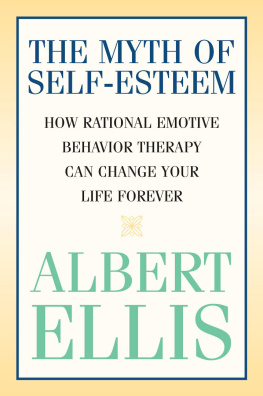Dedicated to my mother, M. a del Valle, an exceptional woman and the first person to teach me the meaning of happiness.
Foreword
After more than 20 years as a family doctor, during which time the emotional balance of the population appears to have progressively diminished while the prescribing of psychotropic drugs, of dubious benefit and controversial efficacy, has increased, I had the opportunity of meeting Rafael Santandreu.
His professional career, his teaching activities and his conceptual contributions and innovations make him, without a doubt, one of todays most authoritative examples for physicians in the field of mental health care.
His therapeutic approach is based, in part, on the legacy of Albert Ellis, the father of Rational Emotive Behaviour Therapy. However, his adaptation of that legacy expands it further by placing the emphasis on exploring the thoughts, conventionalisms and irrational beliefs that we have acquired throughout our lives, which are a cause of suffering and frustration and can, in turn, result in emotional distress and mental disorders such as anxiety and depression. As we make our way through the book, embellished with numerous real-life examples experienced by the author himself, we learn more about the concept that our perception of reality depends, paradoxically, on how we decide to react, which is also something that can be modified by our thinking, emotions and the behaviour that we decide to outwardly express. Santandreus uniqueness lies in the fact that he offers us the keys for making a new start, without necessarily having to delve into our past, for being able to transform ourselves, accept others, become better people and, in short, attain a feeling primarily of happiness.
As the author says, life isnt easy; it is full of challenges and adverse events that need to be resolved. Reading this book prompts us not just to think but to act, though not without effort, while at the same time preparing us for a fuller and more gratifying life in the future.
I hope the reader will be as enthusiastic as I was when I read this book, the essence of which, I believe, lays the foundations of a new era in the treatment of emotional disorders.
Doctor Manuel Borrell Muoz
Specialist in Family and Community Medicine
2009 Professional Excellence Award of the Barcelona College of Physicians
Part One
The Basic Principles
Chapter 1
We Can Change
HIGH STAKES!
On a cold winters morning in 1940, a young man by the name of Robert Capa packed his suitcase with his compact Leica camera, a number of new rolls of film and a few clothes. Nestling in his right-hand jacket pocket was a ticket to board a ship that would take him off to the Second World War. Capa was one of the first combat photographers in the history of journalism, and a wonderful person. Good-looking, likeable, a drinker, brave, and even romantic at times, this Prague-born New Yorker had a fondness for adventure.
On D-Day, hundreds of thousands of American youths were riding jam-packed in amphibious landing craft on their way to the beaches of Normandy. Terror-stricken, and amidst the blasting of the bombs from the German defences, many of these young lads were throwing up their breakfast inside the icy-cold tanks, but nobody complained about it. Their minds had no time to dwell on such trifles. In amongst these boys, Capa shakily checked his cameras, over and over again, as if the work ritual could shut out the deafening noise of the enemy gunfire.
Then, all of a sudden, an abrupt impact shook the craft, indicating that they had reached the shore. By then the noise of the bombs was deafening, but the sergeant in command of the platoon shouted over the din: Out, quick! Regroup at 20 yards! Go! and jumped into the water, holding his rifle aloft and running on ahead.
The boys scrambled out, tripping over themselves, but kept their eyes glued to the back of their senior officer with their hearts pounding like crazy. The worst thing they could do would be to lose their sergeant, their only reliable guide in that hell of a place. All around them was chaos: platoons running here, there and everywhere, cries, explosions Capa followed on behind, copying what the others did, throwing himself to the ground at about 20 yards and keeping his eyes on the back of the sergeants neck. The whiskered 25-year-old veteran shouted out again: OK! Move 20 yards and regroup! Now! Go! and began making his way up a sand dune in leaps and bounds. Of the 20 lads Capa accompanied that morning, only two survived. The photographer just had time to take a few snapshots of those first yards of battleground before he was made to go back in an amphibious tank to one of the Allied ships. Even so, those slightly out-of-focus photographs were the first testimony to the liberation of Europe. By the very next day they were all over the front pages of Britains daily newspapers and the world got a glimpse of the last stand in the war for world freedom.
When he got back to London, Capa was given barely two days leave, which he made the most of with his British girlfriend. Several bottles of Scotch later, he was on board a plane, all set to parachute out of it, camera at the ready, to follow the US militarys subsequent operations in Europe.
What does Capas story have to do with a book on psychology, the reader might ask. Just one thing: Capa squeezed the most out of every day; he lived life intensely. He gambled for high stakes, fearlessly, and was master of his destiny, his life. He was the best photojournalist ever, the lover of Gerda Taro, beau of Ingrid Bergman and close friend of Hemingway. His indomitable spirit led him to live an amazing life before dying in the First Indochina War at the age of 41.
A FIT MIND, AN EXCITING LIFE
For me, Capa is a master of life. There are many others: the explorer Ernest Shackleton, the activist Malala Yousafzai, the writer and musician Boris Vian, the Paralympic swimmer Jessica Long, the physicist Stephen Hawking, the superhero Christopher Reeve Ill be discussing some of them in this book because men and women like these are good role models. For the cognitive psychologist they represent the very opposite of what we are trying to counter, the very opposite of helplessness.
Indeed, the main enemy of the psychologist is what we call neuroticism, that is, the art of making our life miserable through self-inflicted mental torture. Depression, anxiety and obsession are our principal opponents and when we let ourselves get caught up in them we lose the ability to fully enjoy life. Life is for enjoyment: loving, learning, discovering and we will only be able to do that when we have overcome our neurosis (or fear, its main symptom).
One of my first patients, a long time ago, was a 40-year-old man, Ralph, who came to see me because he suffered from panic attacks. He arrived at my practice by taxi, accompanied by his mother. Ralph lived in fear of the idea that he might have a panic attack at any moment. Because of that fear he hardly ever left the house. He had been living as a recluse ever since he was 20 years old when he took indefinite sick leave. Shut away for 20 years because of fear!
Ralphs worst fear was of having a panic attack in the street, far from home or from a hospital where he could get help, but lately he had also been terrified of watching the news on television, because sometimes he had panicked when war scenes were shown. So he no longer watched television. TV programmes arent much good anyway, thats true, but not being able to watch them because of potential panic is taking things a bit too far.
Ralphs life is the antithesis of Robert Capas: one runs its course in the grey zone of existence, and the other is lived in vivid technicolour.
Next page
